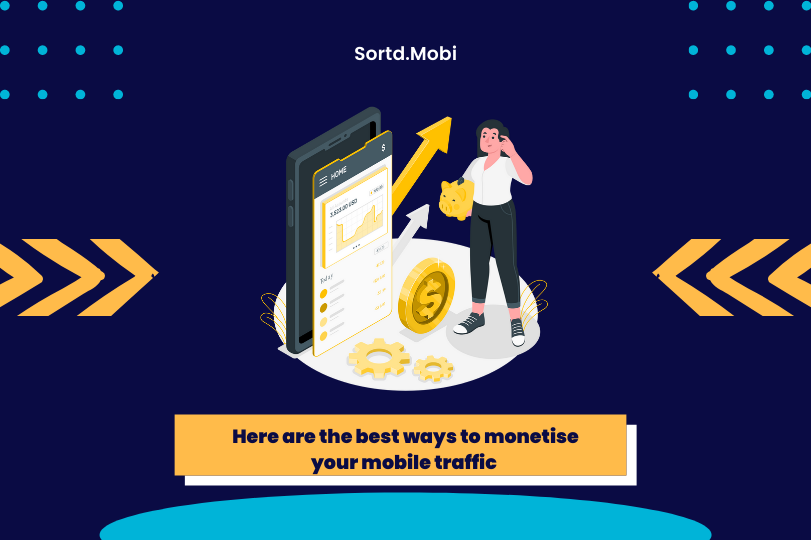The number of internet users is expected to reach 5.3B by 2023, advocating the rise of digital businesses. Many businesses have moved online after the pandemic because, during the lockdown, people had to do almost everything remotely. You may have also noticed that your website is attracting more mobile traffic. You need to stay updated with these changing trends; otherwise, you will lose a significant amount of traffic. In this blog, we will learn various aspects of mobile traffic and ways to monetise mobile traffic effectively.
Why should you take care of mobile traffic?
Mobile traffic is the traffic coming to your website via mobile devices. Basically, when users read your content through smartphones or tablets.
Below are some of the main reasons publishers are more concerned about it.
1. Mobile traffic is more expensive
This type of traffic has already surpassed the cost of desktop traffic. Advertisers are ready to set higher CPMs to attract more mobile users. The bids can be even higher when it comes to carrier traffic.
2. Unoptimised websites lose monetisation potential and traffic
Websites that haven’t adapted to mobile devices will lose potential mobile users. Also, websites with poor layouts will gradually lose loyal audiences while acquiring new traffic at a higher price.
3. Mobile sites tend to rank better
The core web vitals ensure high-quality and convenient user interaction with web resources. So, websites optimised for mobile devices will be displayed higher than those that aren’t.
4. Publishers offering mobile ad placements are in demand
After the pandemic, marketers are investing heavily in advertising to get more traffic and conversions. Publishers offering mobile ad placements had the upper hand.
5. Mobile app developers require new advertising channels
Advertisers need a relevant audience to promote their products, and mobile apps are emerging as a new option for them.
Considerations for mobile traffic monetisation
Mobile traffic monetisation needs specific knowledge about the correct formats and specifics of ad formats. The wrong approach can push away users and deteriorate the website’s ranking in search engines. Below are specific considerations when you want to earn mobile traffic.
1. Optimise your website for mobile devices
Your website must be optimised for various browsers, and it can quickly adapt to multiple screen sizes. Otherwise, you may end up with low visibility of your mobile ads. To resolve this problem, you need to determine how responsive your website is.
In responsive design, the CSS media requests are simultaneously used to match the browser width, just like the flexible design. As a result, your website’s content is displayed accurately. You can consult with a mobile app development services provider for the same.
2. Fast speed of mobile website
Don’t expect the user to stay if your website takes more than 3 seconds to load. Use the services of a reliable hosting provider with professional and consistent tech support. Try Accelerated Mobile Pages (AMPs). They are trimmed down HTML copies to ensure faster loading times. But when it comes to making money, AMPs offer limited ad formats.
How should publishers choose ads to monetise mobile traffic?
Employ a balanced approach when choosing ad formats
When choosing advertising formats, prioritise profit. After all, your site isn’t a bulletin board, so choose a format that sync well with the topic of your website. For example, native ads could be the best pick for a lifestyle blog. A pwa development company can also advise you on the most appropriate ad units.
Optimise ad density
What works on desktops may not work on mobile devices. Take into consideration the screen size of the mobile device. The optimal choice is for your ads not to consume more than 30% of the screen. Otherwise, you will end up with a bulletin board filled with ad offers and users leave such pages immediately.
Set up the display time for the subscription form
If you use feedback forms to collect emails or leads from your subscribers, then configure the display time of this form. Also, make sure you don’t bombard users with many widgets that block the website’s regular content.
Choose on-page ad formats with dynamic iFrame
This technology allows you to employ ad formats that can be expanded or minimised. The best part is that these ads don’t block the regular content. Usually, when such ads pop up, the user loses the ability to manage the content until they close the ad window. Make sure the user’s interaction with these ads is comfortable and not forced.
Consider using sticky page blocks to place ads
Examine the potential of your website builder. If it supports the sticky block, try placing an ad banner. This block will lock your banner in the designed spot while users will scroll the content. This means that the user won’t have to deal with ads popping up while going through the content.
GEO of your users
When choosing the ad formats, besides the website’s topic, you need to keep in mind the GEO of your visitors. What works well for Tier-3 countries may be a complete disaster for Tier 1 countries. Such as pop-up ads are usually too aggressive. It is best to turn to the best android app development company for assistance.
Expert tips regarding mobile traffic monetisation
Mobile monetisation can turn out to be an excellent source of income for publishers if taken seriously. Therefore, it is essential to choose a reliable company that can help you with ad placements and mobile app development stack. Pay complete attention to the ad placement and user experience.


